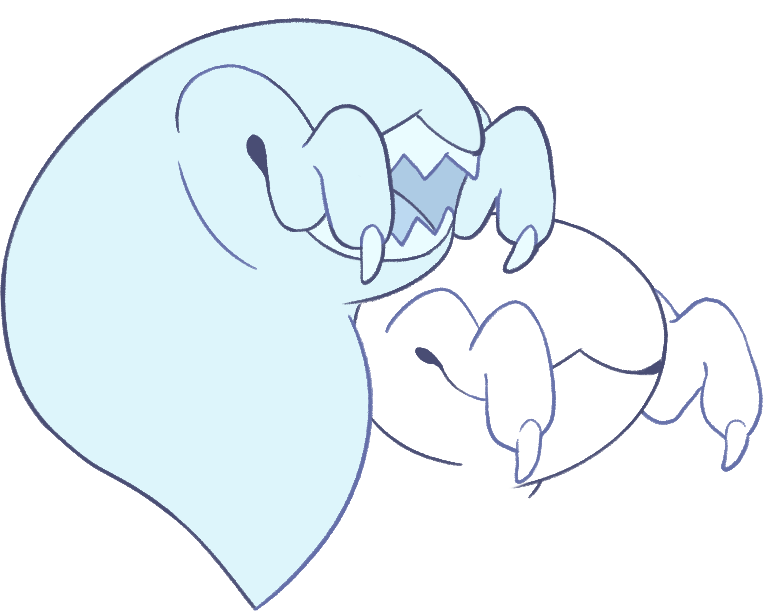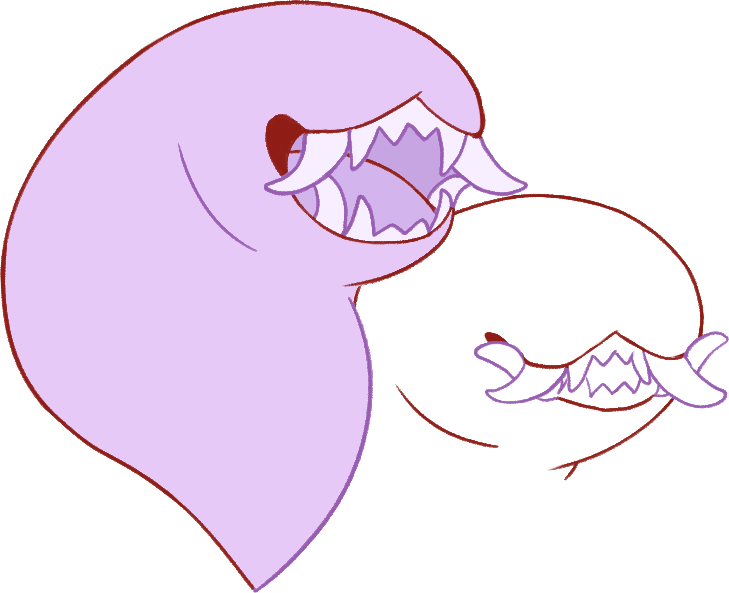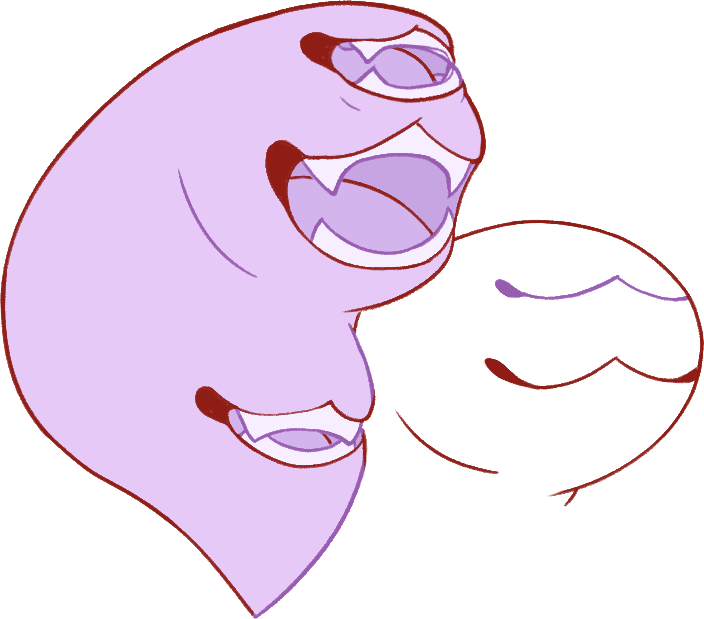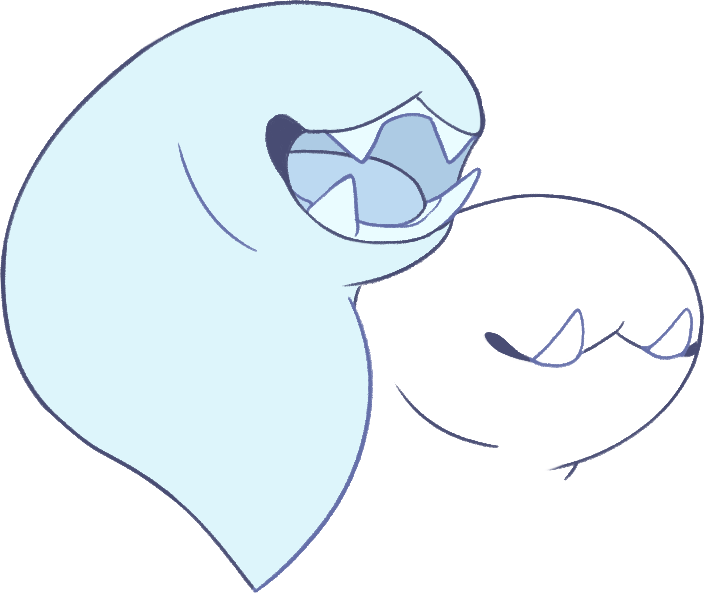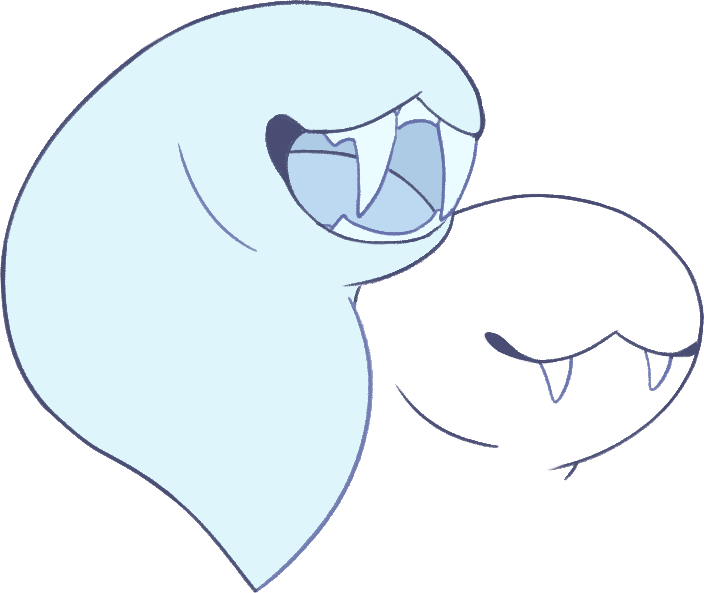Traits
+Spider jaw (Normal)
A popular feature on insectoid leeches, the spider jaw features an advanced claw-tipped feeler that has developed muscles and can be moved about or used to help the leech feed.
The feelers can originate outside or inside the mouth.
These feelers are generally very receptive to touch, and often feature a claw or pointed end as their main use is for grabbing and directing things into the leech's mouth. Claws can be filed down for safety, but the leech must first be trained to be comfortable with this procedure - since the claws are in such close proximity to the mouth it can be easy to receive a bite from a fussy or upset leech.
Note: It may be accompanied by any type of teeth.
+Extra Long Meatstraw (Potion)
[Potion item]: Magic Eclair
Note: It may be accompanied by any type of teeth.
Minor traits may be applied to the meatstraw itself, such as ears or feelers, so long as they do not obstruct the mouth.
Extra Note: This trait is only an extension of the Meatstraw trait, and must already be applied for it to be extended.
+Gulper Jaw (Cave)
Angular folds centered around the jaw muscles that allow the mouth to be opened to a truly fearsome width.
Often used to create a backdraft that essentially sucks smaller creatures in, such as bats, leeches with Gulper jaw have been seen partially enveloping larger targets headfirst, setting their teeth into the neck flesh, and rolling like a crocodile to quickly shred and dispatch prey.
Venus mouth (Common Myth)
A mythical trait where the standard leech mouth is split into quadrants, each lined with sharp teeth, and is named for being reminiscent of carnivorous plants.
This is the only mouth type trait where a leech has small individually-set teeth instead of plates, and as such, cannot be combined with other types.
On occasion, a leech with this trait may have only the upper or lower jaw split, rather than both, resulting in three sections instead of four.
Leeches exhibiting this trait can easily fit the four segments of their mouth around a hare or turkey, and just as easily snap them shut around a human head, taking it clean off a body. It is considered a dangerous trait to work with if the leech has an unpleasant temperament, though this hasn't stopped breeders from trying to incorporate it into vibrant plant themed show-creatures with varying degrees of success.
+Meatstraw (Common Myth)
A strange and unique jaw trait where instead of a standard tongue, the leech develops a sensory organ with a functional face.
This tongue is typically anchored to the floor of the mouth, but there have been some leeches observed to have it originating from farther down the throat.
Leeches with a meatstraw can use it to make a distinctive 'fweep!' noise, and in many cases it can function as a second head with the ability to bite, taste, eat, and in some legendary cases, talk and hold a weapon. Meatstraw leeches often exhibit a higher intelligence as the little faces are very expressive, and are used to communicate their feelings with their owners in a variety of creative ways.
Note: It may be accompanied by any type of teeth.
Minor traits may be applied to the meatstraw itself, such as ears or feelers, so long as they do not obstruct the mouth.
Trade Secret: An extra long tongue may be achieved exclusively by combining the Meatstraw trait with a Magical Eclair item!
Oni Teeth (Common Myth)
Once highly sought after for ornamental and regal leeches, oni teeth are now considered a defective trait where a leech monster will grow an extra tooth on each side of the upper jaw that curves outward and to the sides, preventing them from easily biting their prey.
Leeches with these teeth often have to turn to unconventional food sources or develop other traits in order to compensate for the oni teeth, and its mythical classification is based on the heightened intelligence and adaptive mutations that accompany this leech as it struggles to feed. Oni teeth are considered bad luck, and the superstitious would rather pelt the leech in question before it develops an ability that could harm and kill them.
Note: This leech still has teeth plates in part and should be illustrated as such, though the extra teeth are often standalone set individually into the gum.
+Tusks (Common Myth)
A mythical jaw trait that is thought to have developed alongisde the horn trait, the leech grows impressively long teeth that jut out of the mouth, originating from behind regular teeth plates.
Tusked leeches are rarer than most due to being hunted for sport and ivory. In olden times it was considered a display of manliness and a bragging right to best a tusked leech and put its teeth on display, though this practice has since been banned as it resulted in more human than leech deaths. The manifestation of this trait is largely up to chance as breeders have not been able to replicate it consistently, and modern tusked leeches in the pet and mount classes tend to fetch very high prices because of this.
Note: It may be accompanied by any non-myth type of teeth.
Extra mouths (Common Myth)
A mythical trait that manifests in the form of extra mouths on the leech.
These mouths can behave as a regular mouth by carrying and digesting food to the stomach, making noises, tasting and other such functions, but in some cases they are more like functional pockets with no tract to lead back to the leech's digestive system. Your leech may have a mouth dedicated for screaming and nothing else, so please make sure you are well informed by your breeder before dedicating yourself to a leech featuring this trait!
The jaws and teeth on these mouths can all be the same or a variety of mixed and matched types, the mouths can be placed on anywhere on the body. The mouths can't replace other body parts!
Note: Only one upgrade tadpole is needed to apply several mouths.
+Beak jaw (Normal)
A jaw that deviates from the classic mouth, beaked leeches have faces more akin to a bird or turtle.
The beak jaw is strengthened with cartilage and comes in both blunt and sharp variants. Leeches with this trait are often curious and dexterous, using it to open doors and dismantle objects and generally get into all sorts of things, so an enriching environment and extra attention is a necessity for them lest they take your home apart piece by piece.
Note: It may be accompanied by any type of teeth.
Vampire teeth (Normal)
The classic mouth features a characteristic cat shaped lip and a single concave blade-like tooth on the upper and lower jaw.
Leech mouths typically exhibit either an underbite or overbite to compensate for the shape of their teeth, and the sharp points are used for piercing flesh to draw blood, which serves as the leech's main diet.
+Blush jaw (Normal)
A lesser jaw trait where a pocket develops at the corner of the leech's mouth in the same fashion as a container mutation might, giving the leech the appearance of having cute cheeks.
These differ from markings in that the cheek is functional and can be used by the leech to display blood, fluid, or small trinkets that it feels have value. Incredibly docile leeches may even allow their owners to customize the cheek pockets with their own things, making this trait a popular pick for the decora and ita scenes.
Note: It may be accompanied by any type of teeth.
Outward vampire teeth (Normal)
A genetic defect where the vampiric points of the leech's upper and lower teeth have become bigger and wider than normal, angling out more than the standard variety.
These leeches usually exhibit an underbite, where the bottom two points will stick uncomfortably out of the mouth similarly to bulldogs. While outward vampire leeches live otherwise healthy and happy lives, many regard this particular variant as a sign of poor breeding.
Saber Teeth (Normal)
A unique variation that builds off the vampire teeth crescents, but adds two additional teeth plates to the upper jaw. These teeth extend into notably long fangs, with the much-smaller crescent bridging between them.
These leeches always have an overbite, allowing the saber 'fangs' to peek out when the mouth is closed. While these fangs can be any length, leeches with longer saber teeth often have trouble opening and closing their mouths comfortably.
Clinger Teeth (Normal)
Mimicking the functionality and form of the creatures that leeches are named after, the clinger variation features one tooth in the shape of a solid, serrated ring.
It is controlled by muscles in the leech's head that let it sit further back in the throat and move forward into position when the leech opens its mouth. These muscles are very powerful and bring the teeth forward with a lot of force in order to pierce the flesh of its victims with certainty - clinger leeches do not let go of their prey until they have siphoned every last drop of blood from it.
Rather than hard enamel or similar plating, these teeth are composed of strong cartilage, giving them the flexibility to contract.
Squid Teeth (Normal)
The teeth in this leech's mouth have developed into a single point on the upper and lower jaw, resembling the beak of a squid.
These leeches will always have an overbite, and the top tooth is visible when the mouth is closed. Squid-toothed leeches are experts at piercing holes in things, whether it be hard shells, seafood, containers, or plastic recycling bins. The 'beak' is very dexterous!
Saw Teeth (Normal)
A mutation where points have grown across the whole tooth rather than just at the ends, creating the appearance of a mouth full of teeth.
Like vampire teeth, the leech will have an over- or underbite, if the teeth notches are not built in a way to slot together evenly.
Saw-toothed leeches are very effective at stripping meat from bones and will happily tear through the carcass of their prey. It is considered undesired trait in most pets and mounts, especially if the individual displays nipping tendencies - careless saw teeth can easily remove a finger or take a bite out of a limb.
Note: the inverse points do not reach the gumline; it is still a single solid plate, like a cookie cutter shark.
Whale teeth (Normal)
A flat-toothed variant originally bred for owners who wanted 'safe' leeches that didn't look as gummy as the toothless variety.
While the progenitors this trait type had flat herbivorous teeth, breedings with wild leeches have resulted in the tooth becoming sharp across the whole edge like a cleaver. Despite the harmless sounding name, its always best to double check the sharpness of a whale leech's teeth when shopping for a new companion.
Toothless (Normal)
A variant with no teeth, popular amongst leeches raised for pelting and pets.
While a toothless leech can't puncture skin or damage fingers, a bite from one can still bruise terribly or break bones with enough force behind it. Leeches with this type of mouth feed similarly to constrictors and other snakes by swallowing their prey whole.
